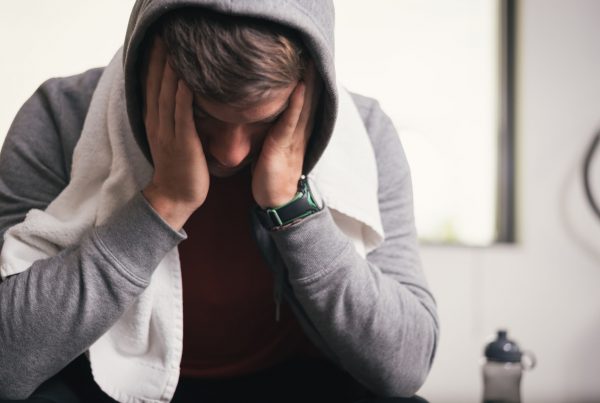”Arkansas, did you know stress and anxiety can be managed with exercise? This week's article explains this link more and also offers tips on how to keep a consistent exercise routine. We hope you find this helpful!
Reading time: 5 Minutes
MWi Hack:
- Learn how depression and anxiety symptoms can improve with exercise
- Get tips on how to start exercising and stay motivated
MWi Summary:
-
- Consistent exercise can help ease depression symptoms through the release of feel-good endorphins, increasing social interaction, and gaining confidence
- Any kind of exercise can provide benefits
- When you think about starting an exercise routine and motivation, you can follow these tips:
- Identify what you enjoy doing
- Get your mental health professional’s support
- Set reasonable goals
- Prepare for setbacks and obstacles
Depression and anxiety: Exercise eases symptoms
Depression and anxiety symptoms often improve with exercise. Here are some realistic tips to help you get started and stay motivated.
When you have depression or anxiety, exercise often seems like the last thing you want to do. But once you get motivated, exercise can make a big difference.
Exercise helps prevent and improve a number of health problems, including high blood pressure, diabetes, and arthritis. Research on depression, anxiety, and exercise shows that the psychological and physical benefits of exercise can also help improve mood and reduce anxiety.
The links between depression, anxiety, and exercise aren’t entirely clear — but working out and other forms of physical activity can definitely ease symptoms of depression or anxiety and make you feel better. Exercise may also help keep depression and anxiety from coming back once you’re feeling better.
How does exercise help depression and anxiety?
Regular exercise may help ease depression and anxiety by:
- Releasing feel-good endorphins, natural cannabis-like brain chemicals (endogenous cannabinoids) and other natural brain chemicals that can enhance your sense of well-being
- Taking your mind off worries so you can get away from the cycle of negative thoughts that feed depression and anxiety
Regular exercise has many psychological and emotional benefits, too. It can help you:
- Gain confidence. Meeting exercise goals or challenges, even small ones, can boost your self-confidence. Getting in shape can also make you feel better about your appearance.
- Get more social interaction. Exercise and physical activity may give you the chance to meet or socialize with others. Just exchanging a friendly smile or greeting as you walk around your neighborhood can help your mood.
- Cope in a healthy way. Doing something positive to manage depression or anxiety is a healthy coping strategy. Trying to feel better by drinking alcohol, dwelling on how you feel, or hoping depression or anxiety will go away on its own can lead to worsening symptoms.
Is a structured exercise program the only option?
Some research shows that physical activity such as regular walking — not just formal exercise programs — may help improve mood. Physical activity and exercise are not the same thing, but both are beneficial to your health.
- Physical activity is any activity that works your muscles and requires energy and can include work or household or leisure activities.
- Exercise is a planned, structured and repetitive body movement done to improve or maintain physical fitness.
The word “exercise” may make you think of running laps around the gym. But exercise includes a wide range of activities that boost your activity level to help you feel better.
Certainly running, lifting weights, playing basketball and other fitness activities that get your heart pumping can help. But so can physical activity such as gardening, washing your car, walking around the block or engaging in other less intense activities. Any physical activity that gets you off the couch and moving can help improve your mood.
You don’t have to do all your exercise or other physical activity at once. Broaden how you think of exercise and find ways to add small amounts of physical activity throughout your day. For example, take the stairs instead of the elevator. Park a little farther away from work to fit in a short walk. Or, if you live close to your job, consider biking to work.
How much is enough?
Doing 30 minutes or more of exercise a day for three to five days a week may significantly improve depression or anxiety symptoms. But smaller amounts of physical activity — as little as 10 to 15 minutes at a time — may make a difference. It may take less time exercising to improve your mood when you do more-vigorous activities, such as running or bicycling.
The mental health benefits of exercise and physical activity may last only if you stick with it over the long term — another good reason to focus on finding activities that you enjoy.
How do I get started — and stay motivated?
Starting and sticking with an exercise routine or regular physical activity can be a challenge. These steps can help:
- Identify what you enjoy doing. Figure out what type of physical activities you’re most likely to do, and think about when and how you’d be most likely to follow through. For instance, would you be more likely to do some gardening in the evening, start your day with a jog, or go for a bike ride or play basketball with your children after school? Do what you enjoy to help you stick with it.
- Get your mental health professional’s support. Talk to your doctor or mental health professional for guidance and support. Discuss an exercise program or physical activity routine and how it fits into your overall treatment plan.
- Set reasonable goals. Your mission doesn’t have to be walking for an hour five days a week. Think realistically about what you may be able to do and begin gradually. Tailor your plan to your own needs and abilities rather than setting unrealistic guidelines that you’re unlikely to meet.
- Don’t think of exercise or physical activity as a chore. If exercise is just another “should” in your life that you don’t think you’re living up to, you’ll associate it with failure. Rather, look at your exercise or physical activity schedule the same way you look at your therapy sessions or medication — as one of the tools to help you get better.
- Analyze your barriers. Figure out what’s stopping you from being physically active or exercising. If you feel self-conscious, for instance, you may want to exercise at home. If you stick to goals better with a partner, find a friend to work out with or who enjoys the same physical activities that you do. If you don’t have money to spend on exercise gear, do something that’s cost-free, such as regular walking. If you think about what’s stopping you from being physically active or exercising, you can probably find an alternative solution.
- Prepare for setbacks and obstacles. Give yourself credit for every step in the right direction, no matter how small. If you skip exercise one day, that doesn’t mean you can’t maintain an exercise routine and might as well quit. Just try again the next day. Stick with it.
Do I need to see my doctor?
Check with your doctor before starting a new exercise program to make sure it’s safe for you. Talk to your doctor to find out which activities, how much exercise and what intensity level is OK for you. Your doctor will consider any medications you take and your health conditions. He or she may also have helpful advice about getting started and staying motivated.
If you exercise regularly but depression or anxiety symptoms still interfere with your daily living, see your doctor or mental health professional. Exercise and physical activity are great ways to ease symptoms of depression or anxiety, but they aren’t a substitute for talk therapy (psychotherapy) or medications.





